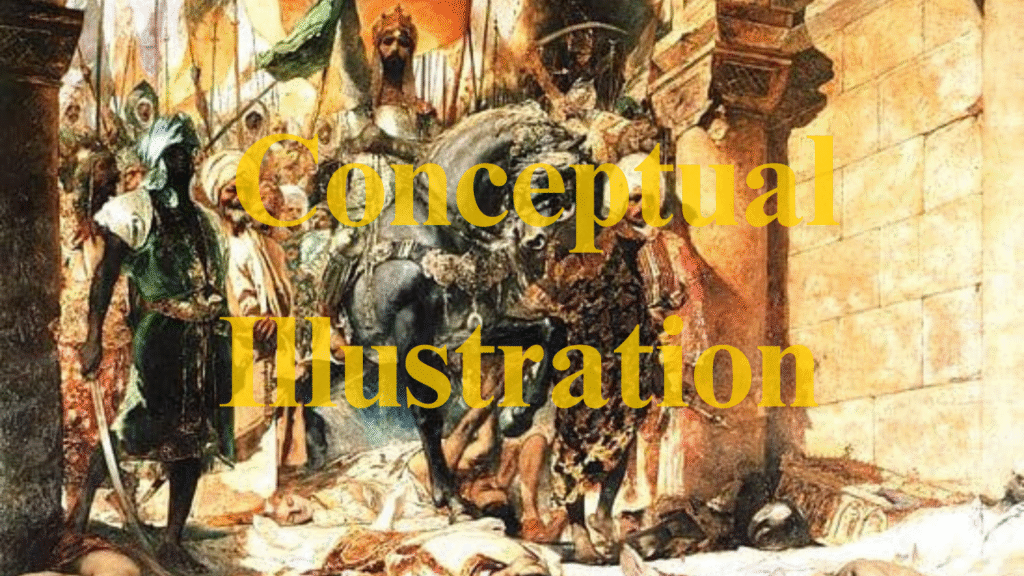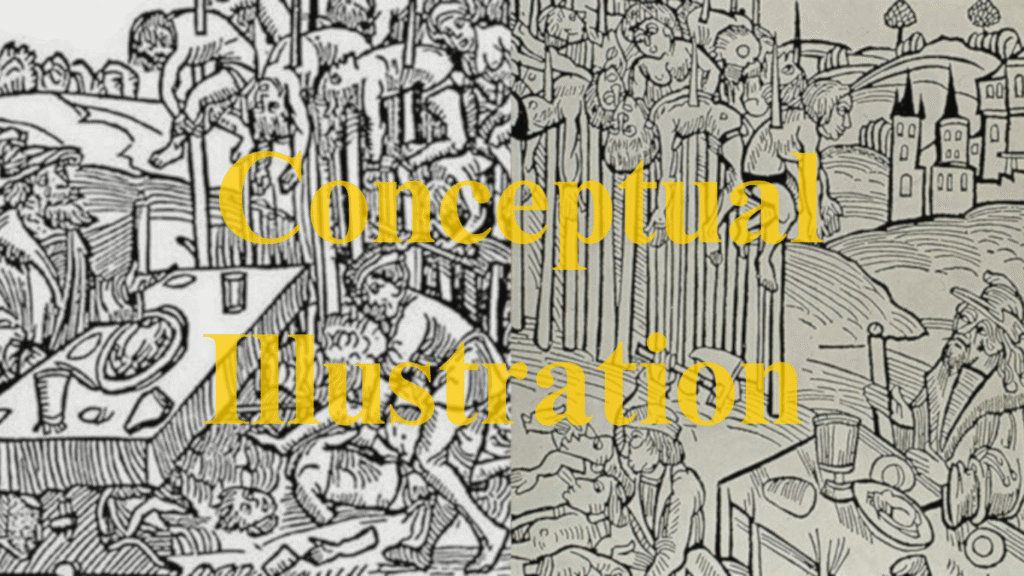In the dark forests of Eastern Europe and the majestic halls of the Ottoman court, two names echoed with both reverence and fear. This is the story of Vlad Dracula and Sultan Mehmed II. One ruled with his vision and steel and the other ruled with blood and spikes.
The legendary battle of Vlad and Mehmed was not just about armies or power. The battle was more than that. This was a battle of ideologies, vengeance, and ego clash. We must dive into the shadows of history to know and understand the real history of this epic battle. In this battle, the myths were blurred with truth, and the fate of nations was shaped by the will of two extraordinary men of that time. As a Bengali history enthusiast, I find this battle fascinating not just for the violence, but for the psychological chess match it became.
The Young Prince Turned Conqueror: Sultan Mehmed II
It was 1432 and a child born into a mighty Ottoman Family who changed the geopolitics of the world forever. His father Sultan Murad II named him Mehmed, and later the world knew him as Sultan Mehmed II, or Fatih Sultan Mehmed—”Mehmed the Conqueror.”
“The young Sultan was no ordinary man. From his boyhood he had shown a precocious intelligence. He was deeply interested in learning; he spoke several languages, including Latin and Greek, and he read widely. Mehmed was passionately interested in the art of war, and his ambition to take Constantinople had grown with the years. He believed that it was his divine destiny.”
— Steven Runciman, The Fall of Constantinople 1453

Mehmed’s early life was so turbulent. He ascended to the throne at a very young age, lost it, and regained it. But it was during his second reign that he changed the world forever.
Mehmed’s greatest aim in life was to conquer Constantinople, which was the shining capital of the crumbling Byzantine Empire. At that time the Ottomans were surrounded by Christian states. So Mehmed saw the fall of the Byzantines not just as a political move, but a divine mission. He assembled one of the largest and most advanced armies of the time. He built the legendary Basilica Cannon, a massive weapon capable of destroying walls.
May 29, 1453, after a 53-day siege, Constantinople finally fell. This fall marked the fall of the Byzantine Empire. This victory of the Ottomans redefined global power. Ottomans renamed the city Islambul (today’s Istanbul). Slowly this city became the jewel of the Islamic world and the heart of the Ottoman Empire. The Byzantine Empire flag, once waving proudly, was replaced by the crescent of the Ottomans.
This victory set Sultan Mehmed to focus now on the Balkans and beyond. He was eager to expand his empire more westward. And soon he met a different kind of enemy—a man who was more terrifying and bloodthirsty than armies: Vlad Dracula.
A Prince of Blood: Vlad Dracula’s Rise
Wallachia was far to the northwest of Mehmed’s empire. It was a small principality between the Ottoman Empire and Hungary. Vlad Dracula was born in Transylvania (Wallachia) in 1431. Transylvania was a land known for mist-covered mountains and whispered legends.
Vlad Dracula’s father, Vlad II Dracul, was a member of the secretive Order of the Dragon—sworn to defend Christianity from the Ottomans. The name Dracula means “Son of the Dragon.”
But after betrayal and political turmoil, Vlad and his brother were taken as political hostages by the Ottomans during their youth. For years, Vlad lived under Ottoman control. In fact, he lived in Sultan Mehmed’s palace for years. But this experience turned him into a weapon of vengeance against Mehmed. Growing up, we used to hear stories of Dracula as a vampire. But the real man was far darker.
Though it is heard that Mehmed treated him as a brother when they were together. After returning to Wallachia, he took the throne and began his bloody rule. His preferred method of punishment was impalement. Thousands died under his iron fist, earning him the name Vlad the Impaler. Though his rule was cruel, it brought order, and his enemies feared him deeply.
Two Powers on a Collision
After the fall of Constantinople, Sultan Mehmed II turned his eyes north. Historians think Mehmed wanted control over the Danube and the Balkan principalities. Mehmed let Vlad Dracula go to Wallachia on the term that Vlad would pay Ottomans tribute. But Vlad had other plans.
He started a bold act of rebellion. Vlad refused to pay tribute and even began attacking Ottoman territories, capturing and impaling thousands of soldiers and envoys.
In one infamous incident, Vlad invited Ottoman diplomats, then nailed their turbans to their skulls when they refused to remove them. This was a provocation of war—and Mehmed wasn’t a man who would let it go unanswered.
Mehmed assembled a mighty force and marched toward Wallachia in 1462. This was marked as one of the most intense and horrifying confrontations of the 15th century.
Guerrilla War, Night Raids, and Psychological Terror
Vlad Dracula and his army were outnumbered by the Ottomans, but Vlad knew his land very well. He used guerrilla tactics, poisoned wells, and scorched-earth strategies to weaken the Ottoman forces.
The most terrifying moment came during the infamous Night Attack at Târgoviște. Vlad launched a surprise assault on Sultan Mehmed’s camp under the cover of darkness to kill Mehmed personally. Though his plan didn’t act accordingly, it surely shook the Ottoman Army.
The next morning, Ottomans faced a terrible scene. Mehmed’s army stumbled upon a forest of impaled corpses—over 20,000 Ottoman prisoners, impaled on spikes. The psychological impact was enormous. The Sultan reportedly stared in silence, then ordered his army to retreat.

Though Ottomans claimed symbolic victory, they did not defeat Vlad. So, for those who ask, “Who won, Mehmed or Vlad?”—the truth is very complex. Sultan didn’t kill Vlad, but he did terrify him to flee away.
What Happened After the War?
After the battle, Sultan Mehmed II installed a puppet ruler in Wallachia. Vlad fled to Hungary and was imprisoned there. But it is heard that eventually he returned to claim the throne again briefly in 1476. The same year he was killed by Ottoman forces. His own men also betrayed him.
Vlad’s head was sent to Mehmed. Mehmed displayed Vlad’s head on the wall of Constantinople on a spike.
So, this question is raised again: Who killed Dracula? It was likely the Ottomans.
And Did the Ottomans conquer Romania? Not directly. But they controlled Wallachia, Moldavia, and Transylvania for centuries through vassalage and political dominance. Full annexation never happened, but the influence was deep and lasting.
The Legacy of Fatih Sultan Mehmed
Sultan Mehmed ruled until 1481. He managed to expand the empire across the Balkans and into Anatolia, reformed its administration, and turned Constantinople into a thriving imperial capital.
So, if you’re wondering: “The Ottoman Sultan Mehmed II helped to strengthen the empire by…” the answer is: through military conquest, cultural patronage, centralized administration, and architectural revival.
There are many mysteries about his death. Some claim he died of illness but some historians claim that Mehmed was poisoned.
So yes: “Was Mehmed II poisoned?”—possibly, though never confirmed or established.
He was succeeded by Bayezid II, answering the query: “Who ruled after Mehmed?”
Was Mehmed II a Genius?
Without any doubt, we can say that he was a polymath. He could speak multiple languages. He was also a patron of scholars, poets and architects. Sultan Mehmed blended Islamic, Persian, and Byzantine traditions, and led one of the most transformative reigns in Ottoman history.
So, “Was Mehmed II a genius?” Yes—militarily, culturally, and politically.
The Man Behind the Vampire: Dracula’s Real Story
Vlad Dracula was brutal, but his legacy is distorted in the West by Bram Stoker’s novel, which turned him into a vampire. This image led to tourist sites like Castle Dracula (often misattributed to Bran Castle), and fictional collections like the Tomb of Dracula Omnibus.
But the real Vlad was no supernatural being. He was a warrior prince fighting for survival in a ruthless world.
So, “Who defeated Vlad the Impaler?” The answer is Ottomans and shifting political alliances eventually led to his downfall.
But Romanians make him a folk hero. They remember him for the resistance against Ottomans.
The battle between Vlad Dracula and Sultan Mehmed II was not just a regional conflict. This battle itself is a legacy. Many historical dramas and movies were made about their epic battle.
The most famous among these is Rise of Empires: Ottomans, a Netflix series, and its second season was made on this historical battle.
Both men were feared and admired. Dracula, for his merciless defiance. Mehmed, for his imperial brilliance. Together, they left a mark on history that still captivates the world.
Read More : Top AI Jobs in 2025: Highest Paying Roles